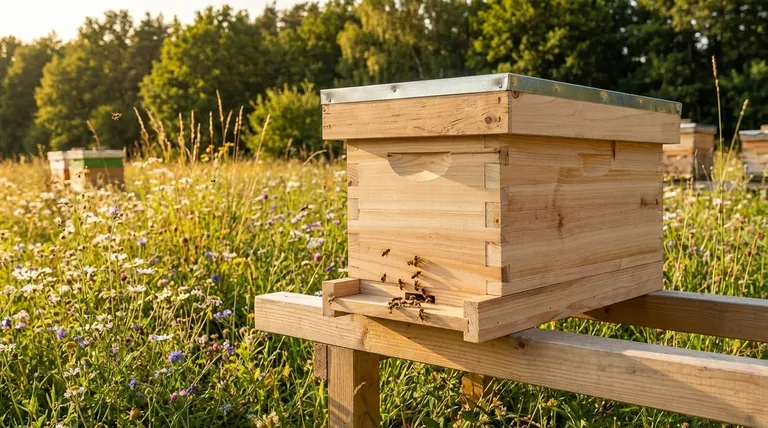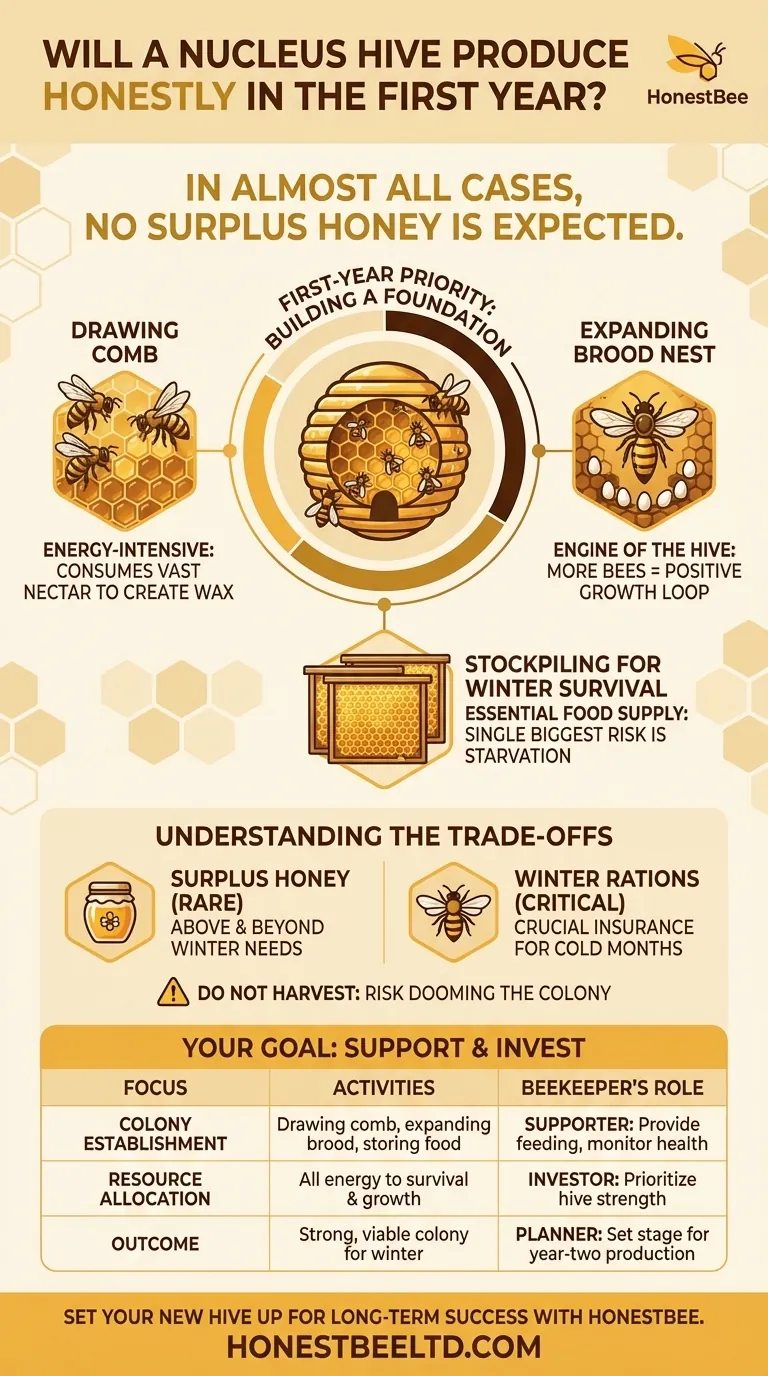In almost all cases, a nucleus hive will not produce a surplus of honey for you to harvest in its first year. This is not a sign of failure but the expected outcome for a new, growing colony. Their energy and resources are focused entirely on the critical tasks of building their home and ensuring their survival.
A new colony's first-year priority is survival and establishment, not honey production for the beekeeper. All their resources are channeled into building comb, raising brood, and storing enough food to survive their first winter.

The First-Year Priority: Building a Foundation
A nucleus hive, or "nuc," provides a head start on establishing a colony, but it is still a small, developing family. Their behavior in the first season is dictated by immense foundational needs that must be met before they can create a surplus.
The Critical Task of Drawing Comb
Bees live on wax comb, but a new hive is mostly empty space. The colony must "draw out" this comb, building the hexagonal cells for brood, pollen, and honey storage from scratch.
This is an incredibly energy-intensive process. Bees must consume vast quantities of nectar to secrete tiny flakes of wax from their bodies.
Expanding the Brood Nest
The queen's primary job is to lay eggs to grow the colony's population. Without drawn-out comb, she has nowhere to lay.
A rapidly expanding brood nest is the engine of the hive. More bees mean more foragers, more comb builders, and a stronger defense, creating a positive feedback loop of growth.
Stockpiling for Winter Survival
Any honey a first-year colony stores is not "extra." It is their essential food supply to survive the cold months when no nectar is available.
A colony that has not stored enough honey will starve over winter. This is the single biggest risk for a new hive.
Understanding the Trade-offs
It is crucial to align your expectations with the colony's natural priorities. Viewing the first year through the lens of hive establishment rather than honey production is key to long-term success.
A Nuc is a Head Start on Establishment, Not Honey
Compared to a package of loose bees, a nuc gives you a significant advantage. It arrives with a laying queen, established brood of all ages, and several frames of drawn comb.
This advantage is geared toward faster colony growth and resilience, not an immediate honey harvest. It shortens the time they need to build a viable population.
The Definition of "Surplus Honey"
Beekeepers only harvest honey that is truly surplus—that is, honey stored above and beyond what the bees need to survive the winter.
A first-year colony rarely, if ever, creates a genuine surplus. Taking frames of honey from their main hive body is taking their winter survival rations.
Resisting the Temptation to Harvest
Even if you see a few frames full of capped honey late in the season, it is critical to leave it for the bees.
That honey is their insurance policy. Removing it can doom an otherwise healthy colony, forcing you to start over from scratch the following spring.
Your Goal for the First Year
Your role as the beekeeper in year one is that of a supporter, not a harvester. Your focus should be on helping the colony build the strong foundation it needs for future productivity.
- If your primary focus is establishing a strong, healthy hive for years to come: Provide consistent support through feeding, monitor their growth, and do not take any honey.
- If your primary focus is harvesting honey as soon as possible: Understand that a successful harvest in year two is entirely dependent on a successful, harvest-free year one.
By focusing on establishment in the first year, you are making the single best investment for strong, sustainable honey harvests in the years that follow.
Summary Table:
| First Year Focus | Key Activities | Beekeeper's Role |
|---|---|---|
| Colony Establishment | Drawing comb, expanding brood nest, storing winter food | Supporter: Provide feeding, monitor health |
| Resource Allocation | All energy goes to survival and growth | Investor: Prioritize hive strength over harvest |
| Outcome | A strong, viable colony ready for winter | Planner: Set the stage for year-two honey production |
Set your new hive up for long-term success with the right supplies from HONESTBEE.
Your first-year goal is colony establishment, and we provide the essential beekeeping supplies and equipment that commercial apiaries and distributors trust. From feeders to help build strong foundations to durable hive components, our wholesale-focused operations ensure you get the quality gear you need.
Contact our experts today to discuss how HONESTBEE can support your beekeeping operation's growth and future productivity.
Visual Guide

Related Products
- 5 Frame Wooden Nuc Box for Beekeeping
- Portable Bee Mating Hive Boxes Mini Mating Nucs 8 Frames for Queen Rearing
- HONESTBEE Professional Multi-Functional Hive Tool with Ergonomic Wood Handle
- HONESTBEE Advanced Ergonomic Stainless Steel Hive Tool for Beekeeping
- HONESTBEE Professional Long Handled Hive Tool with Precision Cutting Blade
People Also Ask
- What are the benefits of using nucs for beginning beekeepers? Ensure a Successful First Hive with a Head Start
- What is the advantage of overwintering a nucleus? A Strategic Asset for Beekeeping Success
- What is the purpose of having a nuc in beekeeping? Build a Resilient & Productive Apiary
- What is the most common type of standard nuc? The 5-Frame Nuc Explained
- What is a common feature of many 5-frame nuc boxes? The Integrated Feeder for Efficient Colony Growth



















